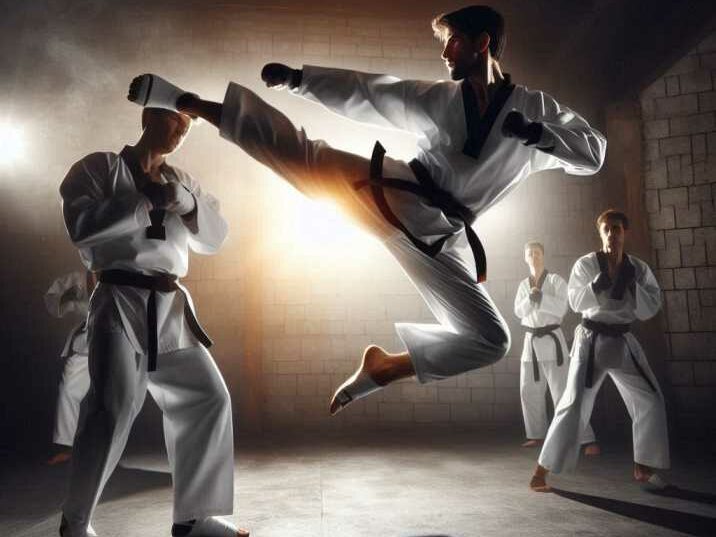Introduction
Table of Contents
Are you curious about Taekwondo and Karate? These two martial arts are popular around the world, They both teach self-defense, discipline, and improve physical fitness. But what makes them different from each other? In this article, we will explore the differences between Taekwondo and Karate in a way that’s easy to understand. So, let’s dive into the world of martial arts and discover what sets these two apart!

What is Taekwondo?
History and Origin
Taekwondo originated in Korea in the 1940s. It was developed by combining various Korean martial arts with influences from Chinese and Japanese martial arts. The name “Taekwondo” translates to “the way of the foot and hand.” It reflects the emphasis on kicking techniques in this martial art.
Main Techniques
Taekwondo focuses primarily on high, fast kicks and spinning kicks. Practitioners use their legs more than their hands. Kicks like the roundhouse kick and spinning hook kick are commonly seen. Taekwondo also includes hand strikes and blocks, but the primary emphasis is on dynamic kicking techniques.
Uniform and Belt System
Taekwondo practitioners wear a uniform called a Dobok, which has a V-neck. The belt system includes different colors and sometimes stripes on the belts to indicate rank and progress. The belt colors typically start with white for beginners and progress through yellow, green, blue, red, and finally black for advanced practitioners.
Competitions
In Taekwondo competitions, athletes compete in sparring and forms (called Poomsae). Sparring involves two opponents fighting under specific rules, while forms are set patterns of movements. Competitors are judged on technique, speed, and accuracy. Taekwondo sparring is an Olympic sport, which has increased its popularity globally.
Philosophy
The philosophy of Taekwondo emphasizes the harmony between mind and body. Practitioners learn to develop respect, integrity, and perseverance. The tenets of Taekwondo include courtesy, integrity, perseverance, self-control, and indomitable spirit.
What is Karate?
History and Origin
Karate originated in Japan, with its roots going back to the 1300s. It was influenced by Okinawan martial arts and Chinese kung fu. The word “Karate” means “empty hand,” signifying that it is a martial art that does not use weapons.

Main Techniques
Karate focuses on powerful punches, strikes, and kicks. The movements are linear and involve precise, strong attacks. Common techniques include the front kick and the straight punch. Karate also incorporates blocks, throws, and joint locks, making it a comprehensive martial art for self-defense.
Uniform and Belt System
Karate practitioners wear a uniform called a Gi, which has a crossover jacket. The belt system includes color belts that indicate the level of expertise, without stripes. Belt colors usually start with white and progress through yellow, orange, green, blue, brown, and black.
Competitions
In Karate competitions, athletes compete in Kata (forms) and Kumite (sparring). Kata involves performing set patterns of movements, while Kumite is sparring with an opponent. Competitors are judged on technique, power, and fluidity. Karate is also recognized as an Olympic sport, with its debut in the Tokyo 2020 Olympics.
Philosophy
The philosophy of Karate emphasizes self-discipline, respect, and continuous self-improvement. Practitioners aim to develop both physical and mental strength. The dojo kun (training hall rules) often includes principles such as striving for perfection of character, being faithful, endeavoring to excel, respecting others, and refraining from violent behavior.
Key Differences Between Taekwondo and Karate
Techniques and Movements
Taekwondo focuses on high, dynamic kicks, while Karate emphasizes powerful punches and strikes. Taekwondo’s movements are often more fluid and acrobatic, whereas Karate’s movements are more linear and grounded. Taekwondo practitioners spend a significant amount of time perfecting their kicking techniques, while Karate practitioners focus more on hand strikes and combinations.
Uniforms
The Dobok in Taekwondo has a V-neck, while the Gi in Karate has a crossover jacket. This difference reflects the unique traditions and styles of each martial art. The uniforms are designed to allow freedom of movement and durability during training and competitions.
Competition Styles
In Taekwondo, competitions are centered around sparring and forms known as Poomsae. In Karate, competitions focus on Kata (forms) and Kumite (sparring). The scoring systems and rules differ, with Taekwondo placing more emphasis on kicks and Karate balancing kicks, punches, and other strikes.
Philosophical Approaches
Taekwondo aims for a harmony between mind and body, promoting integrity and perseverance. Karate emphasizes self-discipline and respect, encouraging continuous self-improvement. Both martial arts instill values of respect, discipline, and mental fortitude, but their approaches to achieving these goals differ.
Health Benefits of Practicing Taekwondo and Karate
Physical Fitness
Both Taekwondo and Karate offer excellent physical fitness benefits. Regular practice improves cardiovascular health, muscle strength, flexibility, and coordination. The rigorous training routines help practitioners build endurance and agility.
Mental Well-being
Practicing martial arts like Taekwondo and Karate also enhances mental well-being. The focus on discipline, concentration, and mindfulness helps reduce stress and improve mental clarity. The philosophies of both martial arts encourage positive thinking and resilience.
Self-Defense Skills
Both martial arts teach valuable self-defense skills. Taekwondo’s high kicks can be effective in keeping an opponent at a distance, while Karate’s powerful strikes and defensive techniques are practical for close combat situations. Learning self-defense builds confidence and provides a sense of security.
Social Interaction
Martial arts classes provide opportunities for social interaction and teamwork. Practitioners build friendships and learn to work together, fostering a sense of community and belonging. This social aspect is especially beneficial for children and teens.
Choosing Between Taekwondo and Karate
Personal Preferences
When choosing between Taekwondo and Karate, personal preferences play a significant role. If you enjoy high-energy, acrobatic movements and powerful kicks, Taekwondo might be the right choice. If you prefer precise, powerful hand strikes and linear movements, Karate could be a better fit.
Goals and Objectives
Consider your goals and objectives. Are you looking to compete in tournaments, improve your physical fitness, or learn self-defense? Both martial arts offer these benefits, but the emphasis may vary. Taekwondo is known for its competitive sparring, while Karate offers a balanced approach to self-defense and competition.
Availability of Classes
Check the availability of classes in your area. Some regions might have more Taekwondo dojos, while others have more Karate dojos. Visit a few classes, meet the instructors, and observe the training environment before making a decision.
Table of Information
| Aspect | Taekwondo | Karate |
|---|---|---|
| Origin | Korea | Japan |
| Main Focus | Kicks and agility | Punches and strikes |
| Uniform | Dobok (V-neck) | Gi (Crossover jacket) |
| Belt System | Color belts with stripes | Color belts without stripes |
| Competitions | Sparring and forms (Poomsae) | Kata (forms) and Kumite (sparring) |
| Techniques | High, spinning, and jumping kicks | Powerful punches and linear strikes |
| Philosophy | Mind and body harmony | Self-discipline and respect |
| Founding Year | 1940s | 1300s |
Conclusion
Understanding the differences between Taekwondo and Karate helps us appreciate the unique qualities of each martial art. Whether you’re interested in the high-flying kicks of Taekwondo or the powerful punches of Karate, both offer valuable lessons in discipline, respect, and physical fitness. Now that you know more about these martial arts, you can make an informed decision if you ever decide to practice one!
Frequently Asked Questions (FAQs)
1. Which is better, Taekwondo or Karate?
Both are excellent martial arts. The choice depends on personal preference and what you want to achieve in your training.
2. Can I learn both Taekwondo and Karate?
Yes, many people practice both martial arts to gain a broader skill set.
3. Is Taekwondo or Karate better for self-defense?
Both are effective for self-defense. Taekwondo is known for its kicks, while Karate is known for its punches and strikes.
4. Do Taekwondo and Karate have different belt systems?
Yes, Taekwondo belts often have stripes, while Karate belts do not.
5. Are Taekwondo and Karate good for kids?
Yes, both martial arts are great for kids. They teach discipline, respect, and improve physical fitness.


